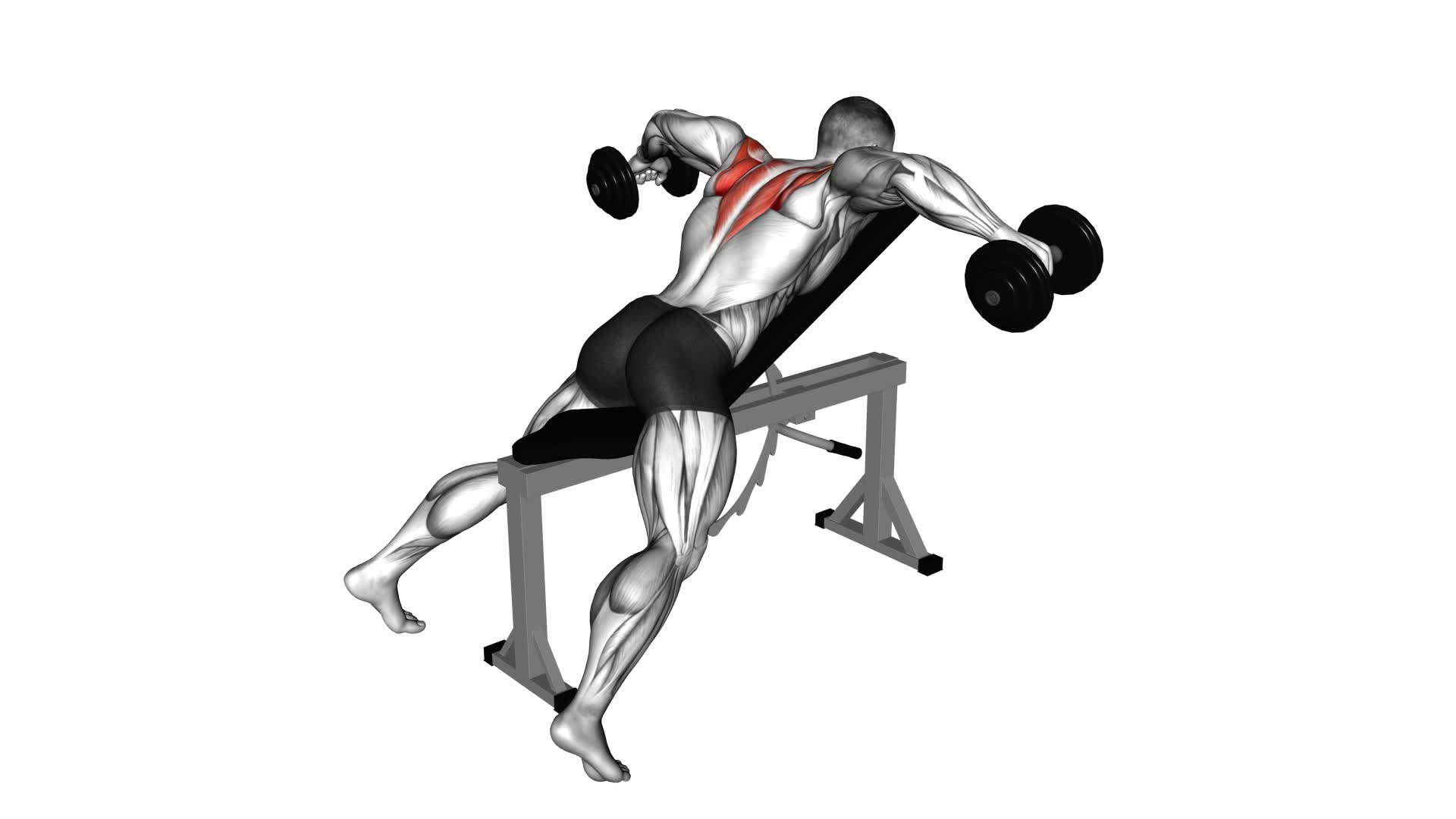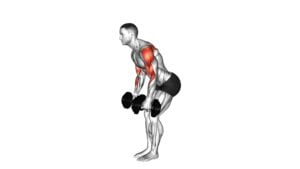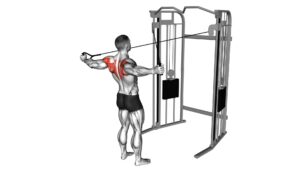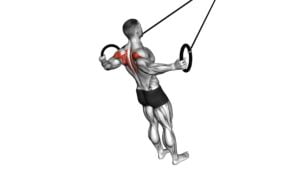Dumbbell Reverse Fly – Video Exercise Guide & Tips

Are you looking to strengthen your back and shoulder muscles?
Watch This Exercise Video
Then the dumbbell reverse fly is the exercise for you!
In this video exercise guide, we'll show you the proper technique and common mistakes to avoid.
Plus, we'll share variations and tips for maximizing your results.
Get ready to sculpt and tone your upper body with this effective exercise.
Let's dive in and get started!
Key Takeaways
- Dumbbell reverse fly targets the upper back muscles, improving posture and reducing the risk of shoulder injuries.
- It is simple to incorporate into a workout routine and requires selecting an appropriate weight dumbbell and standing with feet shoulder-width apart.
- The proper technique involves maintaining a neutral spine, engaging the core, and raising the arms out to the sides while retracting the shoulder blades.
- Common mistakes to avoid include improper grip placement, using excessive weight, and not focusing on squeezing the shoulder blades together at the top of the movement.
Benefits of Dumbbell Reverse Fly
Begin by discussing the benefits of the dumbbell reverse fly exercise. The dumbbell reverse fly primarily targets the muscles of the upper back, specifically the posterior deltoids and the rhomboids. By strengthening these muscles, you can improve your posture and reduce the risk of shoulder injuries.
Incorporating the dumbbell reverse fly into your workout routine is relatively simple. Start by selecting an appropriate weight dumbbell and stand with your feet shoulder-width apart. Hold the dumbbells with a pronated grip, palms facing inward. Bend your knees slightly and hinge forward at the hips, maintaining a neutral spine.
Next, raise your arms out to the sides, squeezing your shoulder blades together as you lift the weights. Hold for a brief moment at the top, then slowly lower the dumbbells back to the starting position. To maximize the benefits, aim for 2-3 sets of 10-12 repetitions, gradually increasing the weight as you become stronger.
Now that you understand the benefits and how to incorporate this exercise into your routine, let's move on to the proper technique for the dumbbell reverse fly.
Proper Technique for Dumbbell Reverse Fly
To perform the dumbbell reverse fly exercise correctly, grasp a pair of dumbbells with a pronated grip and stand with your feet shoulder-width apart.
Here are some key techniques to keep in mind for injury prevention and optimal muscle activation:
- Engage your core by keeping your abdominals tight throughout the movement.
- Maintain a slight bend in your knees to protect your lower back.
- Keep your chest up and your shoulders relaxed.
- Begin the movement by retracting your shoulder blades, squeezing them together.
- Slowly raise your arms out to the sides, maintaining a slight bend in your elbows.
By following these proper technique tips, you can minimize the risk of injury and maximize the effectiveness of the dumbbell reverse fly exercise.
Engaging your core will help stabilize your body and protect your spine. Keeping a slight bend in your knees will prevent strain on your lower back. Maintaining good posture throughout the movement will ensure that your shoulders are properly aligned and your muscles are activated correctly. Finally, focusing on retracting your shoulder blades and squeezing them together will target the muscles in your upper back and improve posture.
Common Mistakes to Avoid
One common mistake to avoid when performing the dumbbell reverse fly exercise is improper grip placement. It's crucial to have a proper grip on the dumbbells to ensure effective engagement of the targeted muscles and prevent any potential injuries. The correct grip involves firmly grasping the dumbbells with your palms facing inward, ensuring that your thumbs are wrapped around the handles. This grip provides stability and control throughout the exercise.
Another common mistake to avoid is using excessive weight. It may be tempting to lift heavier dumbbells to challenge yourself, but using weights that are too heavy can compromise your form and increase the risk of injury. Start with lighter weights and gradually increase the resistance as you become stronger and more comfortable with the exercise.
Improper posture is also a common mistake to watch out for. It's important to maintain a neutral spine and avoid rounding your shoulders or hunching forward during the movement. Keep your chest up and your shoulder blades pulled back and down throughout the exercise.
Lastly, rushing through the exercise is another mistake to avoid. Performing the dumbbell reverse fly with proper form requires controlled and deliberate movements. Take your time and focus on squeezing your shoulder blades together at the top of the movement to maximize the benefits of the exercise.
Variations of Dumbbell Reverse Fly
To add variety to your dumbbell reverse fly workout, you can incorporate different variations of the exercise. Here are five options to consider:
- Resistance band reverse fly: Instead of using dumbbells, you can use resistance bands to perform the reverse fly. This allows for a different type of resistance and can target your muscles in a slightly different way.
- Cable reverse fly: If you have access to a cable machine, you can perform the reverse fly by attaching the cable to your hands and pulling them apart. This provides a constant tension throughout the movement.
- Bent over reverse fly: Instead of standing, you can perform the reverse fly exercise while bent over. This engages your core and lower back muscles more intensely.
- Seated reverse fly: Sitting on a bench or stability ball while performing the reverse fly can help isolate your upper back muscles and prevent any cheating or swinging motions.
- Alternating reverse fly: Instead of performing the exercise with both arms at the same time, you can alternate between left and right arms. This adds an element of challenge and balance to the exercise.
Incorporating reverse fly into a full upper body workout routine is simple. You can include it as part of a circuit or perform it as a standalone exercise. It pairs well with other upper body exercises like rows, chest presses, and shoulder presses.
Tips for Maximizing Your Results
Maximize your results with these tips for the dumbbell reverse fly exercise.
To achieve effective muscle growth, it's important to vary the intensity levels of your workouts. Start with a weight that challenges you but allows you to maintain proper form. As you progress, gradually increase the weight to continue stimulating your muscles.
Incorporating the dumbbell reverse fly into a full body workout routine can also enhance your results. This exercise primarily targets your rear deltoids, but it also engages your upper back and shoulders.
To maximize the benefits, pair the dumbbell reverse fly with other exercises that target different muscle groups. For example, you can combine it with exercises for your chest, arms, and legs. This will provide a well-rounded workout that promotes overall strength and balance.
Remember to maintain proper form throughout the exercise, keeping your back straight and your core engaged.
Frequently Asked Questions
How Many Sets and Repetitions Should I Perform for the Dumbbell Reverse Fly Exercise?
To get the most out of the dumbbell reverse fly exercise, it's important to know how many sets and repetitions to perform.
By focusing on the Current Question, you can learn how to properly perform this exercise and avoid common mistakes.
Understanding the right number of sets and repetitions will help you target the muscles effectively and achieve your fitness goals.
Can I Substitute Dumbbells With Resistance Bands for the Reverse Fly Exercise?
Yes, you can substitute dumbbells with resistance bands for the reverse fly exercise.
Using resistance bands offers several benefits for this exercise.
Resistance bands provide constant tension throughout the movement, targeting your shoulder and upper back muscles effectively.
They also allow for a wider range of motion and are more portable than dumbbells.
Incorporating resistance bands into your reverse fly routine can add variety and challenge to your workout.
Is the Dumbbell Reverse Fly a Suitable Exercise for Beginners?
Yes, the dumbbell reverse fly is a suitable exercise for beginners. It helps to improve overall shoulder strength and stability.
To perform it with proper form and technique, start by standing with your feet shoulder-width apart and a slight bend in your knees.
Hold a dumbbell in each hand, palms facing each other.
Bend forward at the hips, keeping your back straight.
Slowly raise your arms out to the sides, squeezing your shoulder blades together.
Lower the dumbbells back down and repeat.
How Often Should I Incorporate the Dumbbell Reverse Fly Into My Workout Routine?
To maximize results, incorporate the dumbbell reverse fly into your workout routine regularly. The exercise targets your rear deltoids and upper back muscles, improving posture and overall upper body strength.
Aim to perform the exercise 2-3 times a week, allowing for proper recovery between sessions. When performing the dumbbell reverse fly, remember to maintain proper form by keeping your back straight, core engaged, and lifting the weights with control.
Are There Any Modifications or Alternatives for Individuals With Shoulder Injuries or Limitations?
If you have shoulder injuries or limitations, there are modifications and alternative exercises that can help. For modifications, you can try using lighter weights or resistance bands instead of dumbbells. This can help reduce strain on your shoulders.
Additionally, you can perform exercises that target the same muscles as the dumbbell reverse fly, such as bent over lateral raises or cable rear delt flyes. These exercises can provide a similar workout while accommodating your shoulder limitations.
Conclusion
In conclusion, the dumbbell reverse fly is an effective exercise for targeting the muscles in your upper back and shoulders. By using proper technique and avoiding common mistakes, you can maximize your results and reap the benefits of this exercise.
Additionally, you can try variations of the dumbbell reverse fly to keep your workouts challenging and exciting. Remember to follow the tips provided to ensure you get the most out of your workouts.

Author
Years ago, the spark of my life’s passion ignited in my mind the moment I stepped into the local gym for the first time. The inaugural bead of perspiration, the initial endeavor, the very first surge of endorphins, and a sense of pride that washed over me post-workout marked the beginning of my deep-seated interest in strength sports, fitness, and sports nutrition. This very curiosity blossomed rapidly into a profound fascination, propelling me to earn a Master’s degree in Physical Education from the Academy of Physical Education in Krakow, followed by a Sports Manager diploma from the Jagiellonian University. My journey of growth led me to gain more specialized qualifications, such as being a certified personal trainer with a focus on sports dietetics, a lifeguard, and an instructor for wellness and corrective gymnastics. Theoretical knowledge paired seamlessly with practical experience, reinforcing my belief that the transformation of individuals under my guidance was also a reflection of my personal growth. This belief holds true even today. Each day, I strive to push the boundaries and explore new realms. These realms gently elevate me to greater heights. The unique combination of passion for my field and the continuous quest for growth fuels my drive to break new ground.







